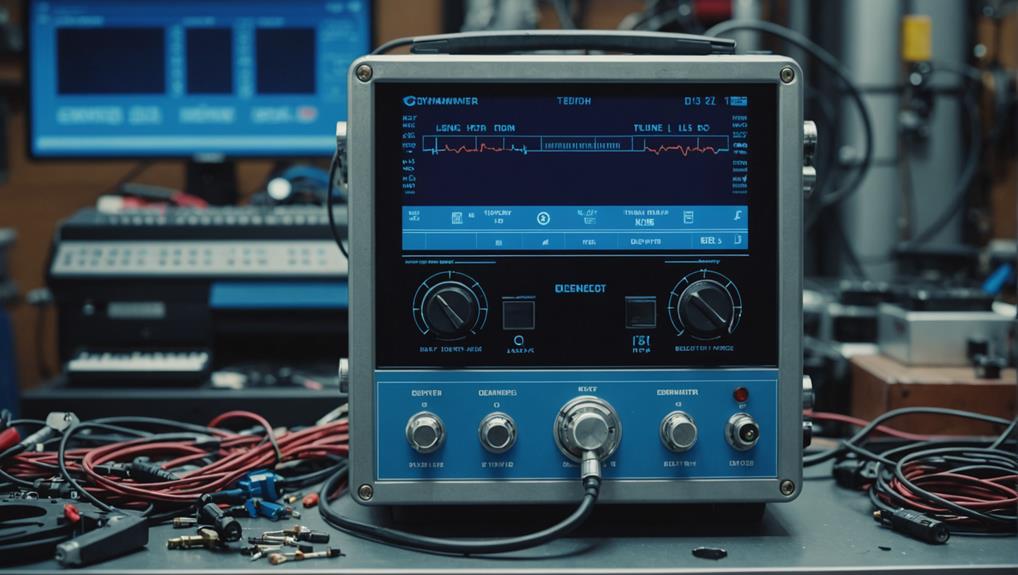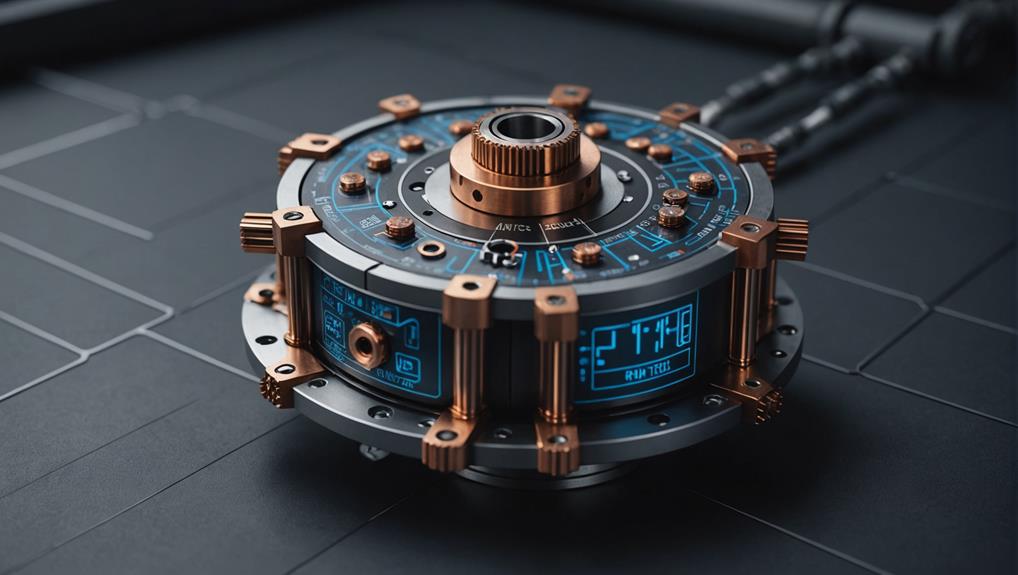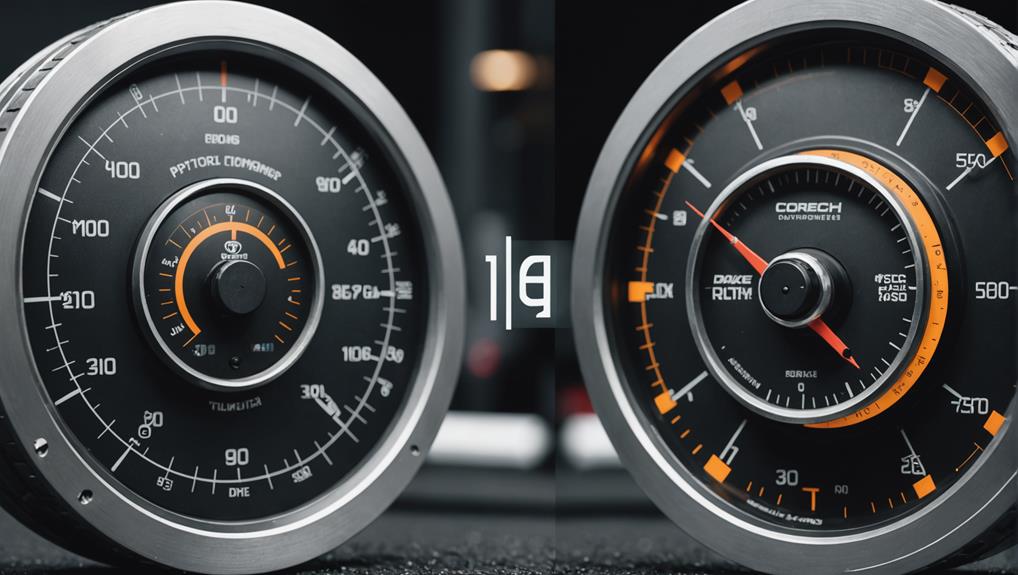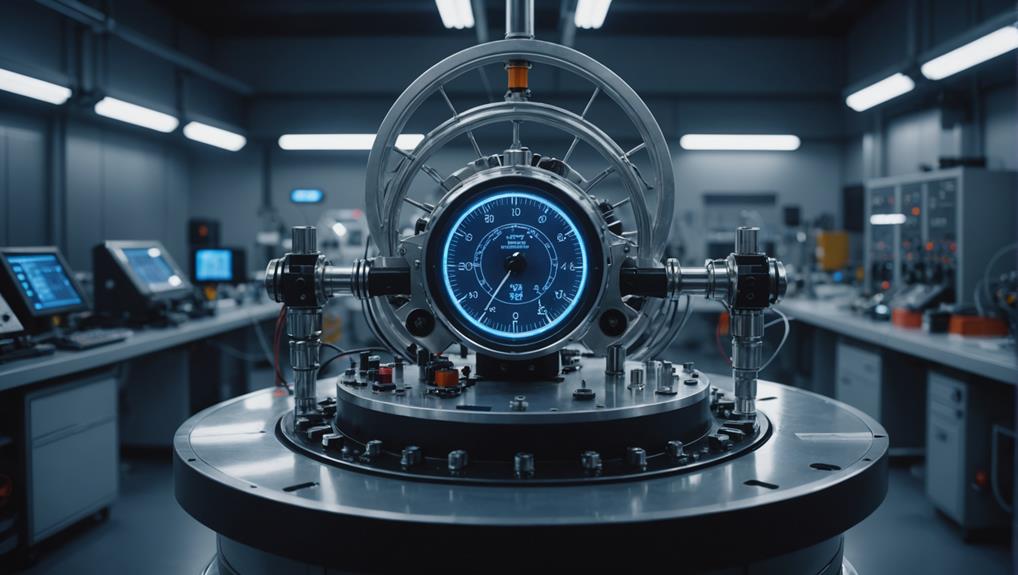
How Dynamometers Enhance Engine Diagnostics and Testing
Necessitating precise measurements, dynamometers unlock the secrets of engine performance, but what else can they reveal about engine diagnostics and testing?
Accurate calibration of inertia dynamometers is crucial for reliable and consistent measurement data, which has a direct impact on power and performance measurements in diverse testing applications.
Calibration checks validate that the dynamometer is functioning within specified tolerance limits, ensuring trustworthy data.
Inertia values have a significant impact on measurement results, and accurate values are imperative for precise measurements.
Regular calibration and understanding inertial effects are fundamental for consistent data. Investigating the principles, methods, and tools of inertia dynamometer calibration guarantees accurate and reliable measurements, tapping the full potential of testing capabilities.
Proper Calibration of Inertia Dynamometers
Accuracy is the cornerstone of any reliable measurement, and inertia dynamometers are no exception.
Calibration of an inertia dynamometer is a critical process that verifies the dynamometer provides accurate and reliable data. Without proper calibration, the measurements obtained can be misleading, leading to incorrect inferences and poor decision-making.
Regular calibration checks are vital to maintain the accuracy of the inertia dynamometer.
These checks help detect any deviations or drifts in the measurement readings, allowing for prompt adjustments to be made. Calibration checks validate that the dynamometer is functioning within the specified tolerance limits, confirming the data collected is trustworthy.
Inertia dynamometer calibration is an ongoing process that requires periodic verification and validation to confirm the dynamometer remains accurate and reliable.
Users can have confidence in the data generated, making informed decisions and optimising their processes, when calibration checks are prioritised.
In the domain of inertia dynamometer calibration, accurately accounting for inertia values is crucial, as even slight miscalculations can substantially impact measurement results.
Inertia values have a direct influence on measurement results, and accurate values for all accelerating bodies are required for reliable data.
The significance of inertia values is evident when considering the following:
Omitting car inertia on an inertial dyno results in a 9% error in power measurement, whereas engine inertia disconnection on loss calculation results in a 6% error.
Inertia information affects measurement accuracy on the dyno, with significant additions to dyno inertia occurring with different vehicles and wheel sets.
Accurate inertia values are vital for precise measurements, as demonstrated by the three-wire pendulum experiment, which can be used to precisely measure vehicle wheel inertia.
Understanding inertia values is particularly crucial when working with a chassis dyno, as it directly affects the dynamometer's ability to accurately measure power and performance.
Professionals can guarantee reliable and consistent data, ultimately leading to more accurate findings and informed decisions, if they grasp the significance of inertia values.
Accurate calibration of inertia dynamometers relies on a range of methods that cater to different testing scenarios and requirements.
These methods guarantee that dyno inertia is accurately measured, providing reliable data for diverse applications.
The three-wire pendulum experiment is a precise method that calculates inertia using the oscillation period, wheel weight, and movement period.
The falling mass inertia calibration tool is another approach, where a known mass is dropped onto the dyno, and the resulting acceleration and deceleration are measured to calculate inertia.
The hard braking inertia calibration tool estimates inertia by braking with full power while measuring torque and deceleration.
Double ramp calibration involves comparing two engine characteristic measurements to calibrate the dyno inertia.
Furthermore, inertia calibration experiments using Dyno2 software tools provide a convenient and accurate method for calibrating dyno inertia, taking into account multiple factors affecting inertia measurements.
Selecting the appropriate method allows users to verify accurate inertia calibration, leading to consistent and reliable data from their inertial dyno.
The selection of an appropriate inertia calibration experiment tool is vital to guaranteeing the accuracy of measurements and reliable data.
In the context of inertia dynamometers, the three-wire pendulum experiment is a precise method for measuring vehicle wheel inertia.
A vital component of the experiment, the pendulum suspension point must be carefully selected to guarantee accurate measurements.
The points at which the wheel is suspended from the pendulum must be precisely controlled to minimize errors.
Accurate measurement of the oscillation period is pivotal, and a high-precision timer is necessary for this purpose.
These experiment tools are vital for measuring rotational inertia, a vital parameter in dyno testing.
Researchers can guarantee accurate and reliable data, which is vital for making informed decisions in the development and calibration of inertia dynamometers, through careful selection and utilization of these tools.
Several key steps are involved in the three-wire pendulum experiment process, a precise method for measuring vehicle wheel inertia.
The wheel is hung from a suspension point using three wires, and the wheel is rotated out of balance by less than 6°. The period of motion is then measured to calculate the inertia.
To guarantee accurate results, the vertical distance between the top suspension points and wheel suspension points in the steady state must be measured, along with the mass of the wheel, gravitational acceleration, and period of oscillation.
If a disk is used in the experiment, its inertia should be measured separately and subtracted from the total inertia. The suspension point and wheel suspension points are critical components that require precise measurement.
The experiment's data is then used in an equation that involves the mass of the wheel, gravitational acceleration, radius of wheel suspension points, radius of top suspension points, and period of oscillation to calculate the inertia.
This method provides a reliable and consistent way to measure vehicle wheel inertia, which is vital for proper calibration of inertia dynamometers in achieving a steady state.
Measuring power with known inertia is a crucial step in ensuring the accuracy of the testing process from a dynamometer calibration perspective.
This is particularly significant for chassis dynos, which rely on precise measurements to provide reliable data. The exact inertia of the system must be known to accurately calculate the power output of the engine or motor being tested.
To achieve this, the following steps are essential:
Accurate inertia measurement is vital for consistent results in dynamometer testing.
To achieve this, precise inertia values must be obtained through reliable calculation methods and calibration tools.
Within the domain of inertia dynamometer calibration, precise calculation of inertia is essential for obtaining consistent results.
Inertia calculation methods play a pivotal role in guaranteeing accurate data, and several approaches can be employed to achieve this.
Commonly used methods for inertia calculation include:
Furthermore, other methods, such as the falling mass inertia calibration tool and hard braking inertia calibration tool, can be used to estimate inertia, providing alternative approaches for determining inertia values.
Professionals can guarantee accurate and consistent data in dynamometer testing, ultimately leading to more reliable results in dyno applications, by employing these inertia calculation methods.
The dynamometer's inertia calibration tools play a crucial role in guaranteeing consistent results, as they enable precise correction of inertia values.
These tools offer diverse methods to correct dyno inertia, leading to reliable and accurate data. The falling mass inertia calibration tool, for instance, provides an accurate way to correct inertia using a simple experiment.
The hard braking inertia calibration tool, in contrast, estimates inertia by braking with full power while measuring torque and deceleration, offering another method for calibration.
Double ramp calibration compares two tests with different inertia effects to calibrate dyno inertia, guaranteeing consistent data across diverse tests.
Inertia calculation from physics experiments or CAD models provides an alternative method for correcting inertia, using mathematical formulas and design models to determine accurate values.
The three-wire pendulum experiment precisely measures vehicle wheel inertia, allowing for accurate correction of inertia values and consistent dyno results.
Utilising these inertia calibration tools, dynamometer users can guarantee precise inertia calibration, leading to reliable and consistent data.
Precise inertia measurement is crucial when the dynamometer's rotational speed and load conditions vary, as minor deviations can significantly impact power measurement and engine performance calculation.
Inaccurate inertia measurement can lead to substantial errors, resulting in a 9% error in power measurement and 6% error in engine inertia disconnection on loss calculation.
To ensure accurate inertia measurement, the following must be considered:
Precise measurements on an inertia dynamometer rely heavily on optimal dyno settings, which involve more than just selecting the correct units and measurement ranges.
To guarantee accurate data collection, it is vital to configure the dyno to operate within a specific range of speed and load conditions, maintaining a consistent load on the engine or motor under test.
The dyno settings must be tailored to the specific application, taking into account factors such as engine type, power output, and testing objectives.
When testing high-performance engines, for instance, the dyno may need to be configured to operate at higher speeds and loads to accurately capture the engine's performance characteristics.
Conversely, when testing low-power engines or motors, the dyno settings may need to be adjusted to accommodate lower speed and load conditions.
Inconsistent testing oversights can substantially impact the accuracy of inertia dynamometer measurements, rendering even the most carefully configured dyno settings useless.
When testing procedures are not thoroughly followed, unreliable data is generated, making it challenging to achieve repeatable results. This inconsistency affects the comparison of data collected on different days, making it difficult to identify trends or patterns.
To avoid inconsistent testing oversights, consider the following:
Proper Calibration of Inertia Dynamometers for Consistent Data
Inertia Dynamometer Calibration Importance
Accurate calibration of inertia dynamometers is crucial for obtaining reliable and consistent data in diverse fields, including automotive, aerospace, and industrial applications. Inertia dynamometers measure the torque and rotational speed of an engine or motor, and any inaccuracies in calibration can lead to misleading results, compromising the integrity of research and development. Hyper Power understands the importance of precise calibration and offers Custom Dyno Solutions, Installation and Setup, Training and Certification, Technical Support and Maintenance, Software Updates and Upgrades, Diagnostics and Performance Analysis, Rental Services, Dynamometer Testing Services, and Accessories and Parts to ensure accurate results.
Grasping Inertia Values and Effects
Inertia values have a profound impact on the accuracy of dynamometer measurements. Inertia is a measure of an object's resistance to changes in its rotational motion. Incorrect inertia values can result in inaccurate torque and power measurements, leading to flawed inferences and decisions. If you have any questions about inertia values and their effects, please do not hesitate to contact Hyper Power.
Calibration Methods for Accurate Data
Two primary methods exist for calibrating inertia dynamometers: the three-wire pendulum experiment and the known inertia method. The three-wire pendulum experiment involves measuring the oscillation period of a pendulum attached to the dynamometer, allowing for the calculation of inertia. The known inertia method involves measuring the power output of a motor with a known inertia value. Hyper Power's experienced team can guide you through these calibration methods to ensure accurate results.
Inertia Calibration Experiment Tools
The three-wire pendulum experiment requires a pendulum, three wires, and a stopwatch or timer. The known inertia method requires a motor with a known inertia value, a power meter, and a dynamometer. Hyper Power provides the necessary tools and expertise for accurate inertia calibration.
Three-Wire Pendulum Experiment Process
The pendulum is attached to the dynamometer, and the oscillation period is measured using a stopwatch or timer. The inertia value is then calculated using the measured oscillation period and the pendulum's length. Our team at Hyper Power can assist you in performing this experiment and calculating the inertia value.
Measuring Power With Known Inertia
The motor with a known inertia value is connected to the dynamometer, and the power output is measured using a power meter. The measured power output is then used to calculate the dynamometer's inertia value. Hyper Power's Dynamometer Testing Services can help you measure power output accurately.
Correcting Inertia for Consistent Results
Once the inertia value is calculated or measured, it is vital to correct for any inaccuracies in the dynamometer's settings. This guarantees consistent and reliable data, enabling researchers and developers to make informed decisions. Hyper Power's Technical Support and Maintenance services can help you correct for any inaccuracies and ensure consistent results.
Dyno Settings for Precise Measurements
Dynamometer settings, such as the sampling rate and filtering, must be optimized for precise measurements. Incorrect settings can lead to inaccurate data, highlighting the importance of proper calibration and setup. Hyper Power's Installation and Setup services can help you optimize your dynamometer settings for precise measurements.
Avoiding Inconsistent Testing Oversights
Neglecting to calibrate inertia dynamometers can result in inconsistent and inaccurate data, leading to flawed inferences and decisions. It is vital to prioritize proper calibration and setup to guarantee reliable and consistent results. Hyper Power's Training and Certification programs can educate you on the importance of proper calibration and setup.
Final Thoughts
Proper calibration of inertia dynamometers is vital for obtaining consistent and accurate data. By grasping inertia values and effects, utilizing calibration methods, and correcting for inaccuracies, researchers and developers can guarantee reliable results, ultimately leading to informed decisions and advancements in their respective fields. If you require any assistance or guidance on inertia dynamometer calibration, please contact Hyper Power for our expert services.

Necessitating precise measurements, dynamometers unlock the secrets of engine performance, but what else can they reveal about engine diagnostics and testing?

Navigating the complexities of torque measurement requires a deep understanding of the underlying principles and mechanisms to ensure accurate results.

Precise control and optimization of engine performance await, but only for those who unlock the secrets of dynamometer-driven data analysis.

Gaining insight into the differences between inertia and brake dynamometers is crucial for ensuring accurate testing results in various industries.

Tapping into the precise measurement capabilities of dynamometers, uncover the secrets to optimizing fuel efficiency and slashing emissions in the automotive industry.

Witness the importance of rigorous safety protocols and best practices in dynamometer testing to avoid catastrophic failures and ensure accurate results.

Harnessing the nuances of precision measurement is crucial to avoiding costly errors in dynamometer testing, but what are the key factors to consider?

Witness the transformative power of dynamometers in unlocking your vehicle’s hidden performance potential, but only if you know how to harness their precision.